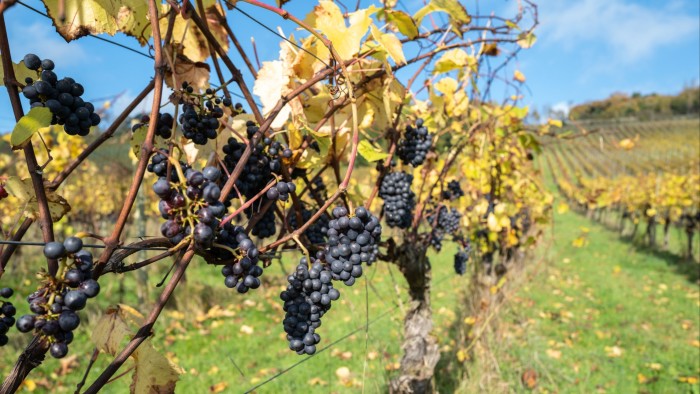Planted in the chalk soil of the rolling hills of Surrey, Denbies, England's largest vineyard, is one of the wine sector's biggest success stories, producing one million bottles and attracting 400,000 visitors a year.
But chief executive and owner Christopher White said ministers should support the British wine industry by creating a level playing field with European producers, whose governments, unlike the UK, impose little or no tax duty on domestic wine.
White said the only way for producers to make a return after paying exorbitant fees to distributors and fees to HM Revenue & Customs was to sell to visitors to their vineyards at the “cellar door”, cutting out the middleman.
“If we relied solely on outside sales, I'm not sure I can say we would be here today,” White said, noting that his 265-acre property aims to make 50 percent of sales direct to the customer. “The profit margin for the farmer is small, if any at all, and what that does not allow for is a good or bad harvest.”
English winemakers are urging Chancellor Rachel Reeves to introduce tax breaks in next week's budget for locally produced wine, as the fast-growing sector struggles with low returns, an increasingly volatile climate and intense competition.
There are now 1,030 vineyards in the UK, more than double the number of a decade ago, according to trade body WineGB. Excitement over the industry's rapid growth has prompted more growers to diversify into viticulture, and inspired wealthy wine enthusiasts to set aside excess funds to establish estates.
The bumper harvest produced 21.6 million bottles of wine across Britain last year, a 77 per cent increase on 2022. Sales rose 10 per cent in the same period. But winemakers in England this year suffered the second-worst harvest on record, official data shows, with persistent wet weather and diseases hitting the vines.
Chapel Down shares fell on Friday after England's biggest wine brand cut its sales guidance on the back of a poor harvest, and withdrew its sale plans following a strategic review.
Winemakers said HMRC's tariffs on wine put them at a disadvantage to European producers, and trade groups called for subsidies for small producers to be extended to support the sector's growth.
The tax break, which led to the craft brewing boom of the 2000s, allows companies that produce beverages measured at less than 8.5 percent alcohol by volume (ABV) to pay a lower duty rate.
In August 2023, the then Conservative government implemented a new alcohol duty regime, under which drinks with a stronger alcohol content would be taxed at a higher rate. The easement on wines from 11.5 per cent to 14.5 per cent ABV will expire on February 1, and wine importers have warned that the change will push up prices for consumers.
Victoria Vivian, president of the Rural Land and Business Association, which speaks on behalf of rural landowners and businesses, said the taxes meant producers “often pay more in fees than they get in profits”. “Cutting the tax… we will see British vineyards flourish,” she added.

The UK is one of the few countries in Europe that applies tariffs to domestic wine. Ten EU member states, including Spain, Italy and Portugal, do not impose such a tax on domestic and sparkling wines. Most of the rest charge less than €1 per bottle, according to a WineGB analysis.
France – which produced nearly a third of all wine in Europe last year, according to the International Vine and Wine Organization – is charging €0.03 per bottle of still wine and €0.07 per bottle of sparkling wine in 2022.
The current UK system applies a flat duty rate of £2.67 to wines between 11.5 and 14.5 per cent ABV.
Industry bodies in Britain say lower tariffs will help stimulate sales, which in turn, they say, will lead to increased customs duties collected. The Office for Budget Responsibility, the financial watchdog, estimates that HMRC collected £12.7 billion in the 2023-24 tax year.
Nicola Bates, CEO of WineGB, said: “Tariff rates are a lag behind the level of growth we could have, and a reduction in overall duties, or exemptions, will provide great reassurance to our businesses and enable them to invest and grow.”
Trade groups have proposed “cellar door relaxation” that would allow producers to claim a tax break on sales made at actual wineries, saying the change would also boost wine tourism. In a pre-Budget report to the Treasury, WineGB suggested such a scheme would cover 13,500 bottles per vineyard.
The Treasury said it “supports businesses, including UK winemakers, with pledges to make the business rates system fairer, cap corporation tax at 25 per cent, and publish a corporate tax roadmap.”

Small producers, who make up the majority of UK wine companies, are particularly reliant on cellar door sales because they cannot achieve the volume of larger competitors who sell through supermarkets and in pub and restaurant chains.
Peter Townsend, head of wine at Dunsford Vineyard in West Yorkshire, one of Britain's northernmost vineyards, said he paid £2 to £3 in customs duties per bottle of wine, which was passed on to customers.
“There is an existing facility that can be expanded to include wine,” Townsend said. “It was designed for a time when England was not making wine. If we had put in place an exemption for small producers today, it would have been as high as 15 per cent.”
The family-run Dunesforde company, which planted its first vines in 2016 and made its first wine three years later, produces between 10,000 and 15,000 bottles a year from its four acres of land. About 75 percent of the produce is sold at the cellar door, while restaurants buy the rest at break-even prices, largely as a marketing strategy, Townsend said.
“The vast majority (of vineyards) are not going to survive in the environment right now,” he said. “For almost everyone, this is a passion project, not a get-rich-quick scheme.”


